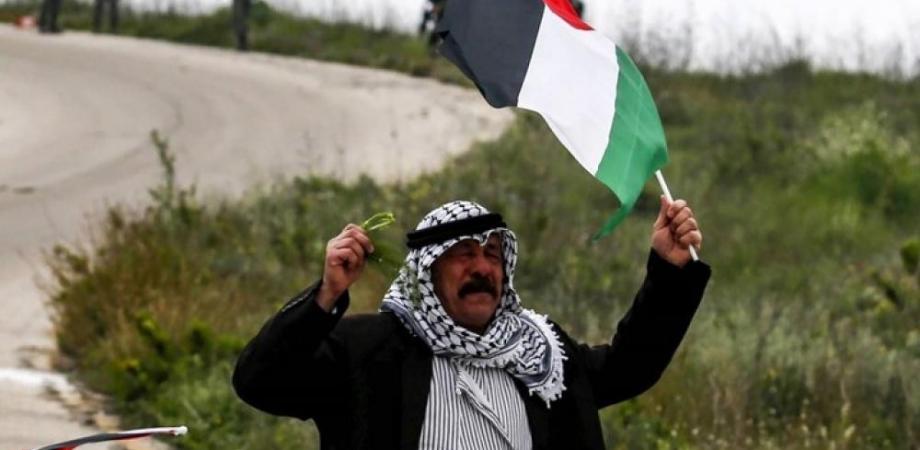Today, Tuesday coincides with the 45th anniversary of the Palestinian Land Day that came after the revolt of the Palestinians in the occupied territories in 1948, on March 30, 1976, announcing a revolution in the face of the deportation and Judaization policies pursued by Israel.
Palestinians in the occupied territories in 1948, the West Bank, the Gaza Strip, and the diaspora, and the solidarity activists from all over the world, are preparing to commemorate this memory.
It is noteworthy that the spark of this day was ignited by the Israeli authorities' confiscation of about 21,000 dunums of lands from many Palestinian villages in Galilee, including Arraba, Sakhnin, Deir Hanna, Arab Assawad, and others.
By this step, Israel aimed to establish more settlements within the scope of the plan to Judaize the Galilee and empty it of its inhabitants, which led to the announcement of a general strike on the thirtieth of March by the Palestinians in the occupied territories in 1948, especially those directly affected.
Strike
On this day, the cities and villages of Galilee struck a general strike, and the Israeli forces tried to break the strike by force, which led to a clash between the citizens and the Israeli forces, the fiercest of which was in the villages of Sakhnin, Arraba and Deir Hanna.
According to the High Follow-Up Committee for Arab Citizens of Israel, Israel confiscated about one and a half million dunams since its occupation until 1976, and only about half a million dunams were left in the possession of the Palestinians, except for millions of dunams of refugee property and public communal lands.
Researchers indicate that the confiscation of lands for Judaization culminated in early 1976 under various pretexts, including the law and serving the public interest, or inactivating what are known as the mandatory emergency laws.
The decision of the Committee for the Defense of Arab Lands, which emerged from local committees, came within the framework of a general meeting held in the city of Nazareth on October 18, 1975.
The general strike was announced, in direct response to the confiscation of the lands, which has an area of 60 thousand dunums and was used in 1942-1944 as a military training area for the British army during World War II, in exchange for paying a rental fee to the owners of the land.
Israeli secret Kining document
The issuance of the Israeli secret document on the first of March 1976 by the administrator of the Northern Brigade in the Israeli Ministry of Interior (Yisrael Kinning), later named after him, which aims to empty the Galilee of its Palestinian people and seize their lands and Judaize them, and one of the causes of the trend towards the strike.
The Kinning document called in its entirety to reduce the percentage of Palestinians in the Galilee and Negev regions, by seizing what they had left of agricultural lands and by besieging them economically and socially, and directing new Jewish immigrants to settle in the Galilee and Negev regions.
The document stressed the need for economic restrictions on Arab families by pursuing them with taxes, as well as reducing the percentage of Arabs in educational attainment, encouraging professional orientations among students, and facilitating the migration of Arab youth and students outside the country and preventing their return to it.
The Israeli response was severe militarily to the Land Day revolt, as it was the first challenge, and for the first time after the occupation of the Palestinian Territory in 1948, when reinforced Israeli forces backed by tanks and armored vehicles entered the Palestinian villages and re-occupied them.
The events resulted in martyrs and injuries among the Palestinians, and the outcome of the clashes was the death of 6 people.
Despite the demands of the Palestinians of the occupied territories in 1948 to establish a committee to investigate the killing of unarmed civilians with Israeli citizenship by the Israeli army and police, claiming that the army faced hostile forces.
Despite the passage of 41 years since this anniversary, the Palestinians in the occupied territories, who numbered about 1.3 million people after they were only 150 thousand people in 1948, did not tire of celebrating Land Day, which they unanimously say is the most prominent day of their struggle, and that it is a historical turning point in the march of their survival. And their belonging, and confirmation of their attachment to their homeland and their land.
Palestinian land
The Palestinian land is the first pillar for the success of the Israeli project, according to the Zionist literature, especially issued by the First Zionist Congress in Basel, Switzerland, in 1897 AD.
Since the establishment of the entity, the occupation has been practicing a policy of Judaizing Arab lands and displacing the Palestinians. The authorities have not only confiscated the lands of the Palestinians who were expelled from their land but have worked to confiscate what remains of the land that remained in the possession of those who remained in their land.
The Palestinians believe that the commemoration of Land Day is not just a narrative of historical events, but rather a new battle in a continuous war to restore Palestinian rights.
Since 1976, Land Day has become a national day in the life of the Palestinian people inside and outside Palestine, and this occasion witness many Palestinian popular movements that affirm the unity of the Palestinian people and their right to their land.
It is noteworthy that the Israeli occupation exploits more than 85% of historic Palestine, which is about 27,000 km2, leaving only about 15% of the land area for the Palestinians, according to the Central Bureau of Statistics.
Source : Safa

